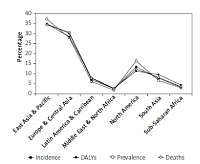Current issue
Archive
Manuscripts accepted
About the Journal
Editorial office
Editorial board
Section Editors
Abstracting and indexing
Subscription
Contact
Ethical standards and procedures
Most read articles
Instructions for authors
Article Processing Charge (APC)
Regulations of paying article processing charge (APC)
GASTROENTEROLOGY / CLINICAL RESEARCH
The global burden of pancreatic cancer
1
Section of Clinical Biochemistry, University of Verona, Verona, Italy
2
Service of Clinical Governance, Provincial Agency for Social and Sanitary Services, Trento, Italy
Submission date: 2019-08-06
Final revision date: 2019-09-13
Acceptance date: 2019-09-14
Online publication date: 2020-05-04
Publication date: 2020-05-26
Arch Med Sci 2020;16(4):820-824
KEYWORDS
TOPICS
ABSTRACT
Introduction:
We provide here an overview on current worldwide epidemiology of pancreatic malignancies, obtained from Global Health Data Exchange (GHDx) and World Health Organization (WHO) repositories.
Material and methods:
Electronic searches for collecting information on pancreatic cancer epidemiology were performed in official repositories of GHDx and WHO, and retrieved data were then analyzed.
Results:
Overall, 447 665 new cases of pancreatic cancer were recorded around the world in 2017 (58.6 per million), with global prevalence of 49.8 per million and 441 083 deaths (57.7 per million). Incidence, prevalence and mortality increased by 55%, 63% and 53% during the last 25 years. Pancreatic cancer accounts for 1.8% of all cancers, causing 3.9% of all cancer disability- adjusted life years (DALYs) and 4.6% of all cancer deaths. No sex differences can be observed for incidence, prevalence and mortality, whilst DALYs are marginally higher in men. Incidence, prevalence and mortality follow a similar age-related trend, with gradual escalation after 30 years of age, reaching the highest burden after 80 years of age. The DALYs peak between 55 and 74 years, and then decline. The epidemiologic burden is positively associated with socio-demographic status. The largest burden of pancreatic cancers is observed in the East and Asia Pacific region, whilst the lowest is found in the Middle East and North Africa. Pancreatic cancer deaths are expected to increase by ~1.97-fold by the year 2060.
Conclusions:
Although pancreatic cancer remains relatively infrequent, its clinical, societal and economic burden is noteworthy. Future projections suggest that its burden may double during the next 40 years.
We provide here an overview on current worldwide epidemiology of pancreatic malignancies, obtained from Global Health Data Exchange (GHDx) and World Health Organization (WHO) repositories.
Material and methods:
Electronic searches for collecting information on pancreatic cancer epidemiology were performed in official repositories of GHDx and WHO, and retrieved data were then analyzed.
Results:
Overall, 447 665 new cases of pancreatic cancer were recorded around the world in 2017 (58.6 per million), with global prevalence of 49.8 per million and 441 083 deaths (57.7 per million). Incidence, prevalence and mortality increased by 55%, 63% and 53% during the last 25 years. Pancreatic cancer accounts for 1.8% of all cancers, causing 3.9% of all cancer disability- adjusted life years (DALYs) and 4.6% of all cancer deaths. No sex differences can be observed for incidence, prevalence and mortality, whilst DALYs are marginally higher in men. Incidence, prevalence and mortality follow a similar age-related trend, with gradual escalation after 30 years of age, reaching the highest burden after 80 years of age. The DALYs peak between 55 and 74 years, and then decline. The epidemiologic burden is positively associated with socio-demographic status. The largest burden of pancreatic cancers is observed in the East and Asia Pacific region, whilst the lowest is found in the Middle East and North Africa. Pancreatic cancer deaths are expected to increase by ~1.97-fold by the year 2060.
Conclusions:
Although pancreatic cancer remains relatively infrequent, its clinical, societal and economic burden is noteworthy. Future projections suggest that its burden may double during the next 40 years.
Share
RELATED ARTICLE
We process personal data collected when visiting the website. The function of obtaining information about users and their behavior is carried out by voluntarily entered information in forms and saving cookies in end devices. Data, including cookies, are used to provide services, improve the user experience and to analyze the traffic in accordance with the Privacy policy. Data are also collected and processed by Google Analytics tool (more).
You can change cookies settings in your browser. Restricted use of cookies in the browser configuration may affect some functionalities of the website.
You can change cookies settings in your browser. Restricted use of cookies in the browser configuration may affect some functionalities of the website.



